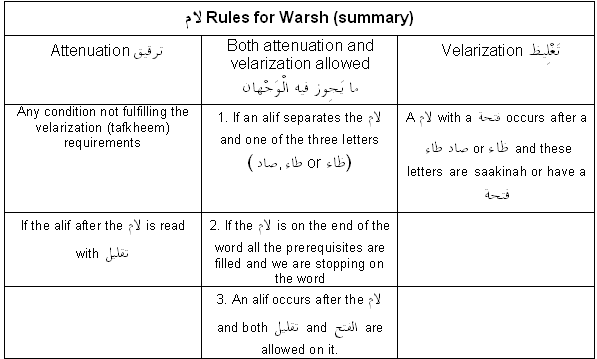Question
Assalamu
alaykum.
Could you
please outline the rules for laam in Warsh. I was listening to Warsh and found
that there are differences in tafkheem.
jazakallahu
khayran. wa salaam
Answer
Wa alaikum
assalaam wa rahmatu Allahi wa barakatuh.
Heaviness
 of the
of the

The
terms
 and
and
 are
synonyms. The scholars tend to use
the word
are
synonyms. The scholars tend to use
the word
 for
velarization of the letter
for
velarization of the letter
 ,
and tend to use the word
,
and tend to use the word
 for
velarization of the
for
velarization of the
 . Warsh
has
. Warsh
has
 of
of
 when
all of the following conditions
are met:
when
all of the following conditions
are met:
A.
 has
a fat-hah.
has
a fat-hah.
B.
 is
preceded by
is
preceded by
 ,
,
 ,
or
,
or
 .
.
C. These three
letters (
 ,
,
 ,
or
,
or
 ) have either a fat-hah or a sukoon.
) have either a fat-hah or a sukoon.
If
all three of these conditions are met, then there is
 of
the
of
the
 .
Examples of this are found in the following words:
.
Examples of this are found in the following words:



 .
.
There are two
ways of reading the following words (meaning with tafkheem of the
 and
without) because of the alif between the letter causing
the tafkheem and the
and
without) because of the alif between the letter causing
the tafkheem and the
 :
:

 in aayah surah Al-Baqarah,
and
in aayah surah Al-Baqarah,
and  in aayah 128 of surah An-Nisaa’.
in aayah 128 of surah An-Nisaa’.
There
are also two allowed ways of reading words fulfilling the conditions, but the
letter
 is
the last letter of the word and one is stopping on it with an incidental
(temporary) sukoon. Examples of this are when stopping on the following words:
is
the last letter of the word and one is stopping on it with an incidental
(temporary) sukoon. Examples of this are when stopping on the following words:
 and
and  .
.
If
there is an alif following the
 and
there are two possible ways of reading the alif, with
and
there are two possible ways of reading the alif, with
 and absence of any type
and absence of any type  when stopping and/or continuing on the alif, then two ways are allowed for the
when stopping and/or continuing on the alif, then two ways are allowed for the
 .
When reading without
.
When reading without
 there is
there is
 of
the
of
the
 and
when reading with
and
when reading with
 there
is tarqeeq of the
there
is tarqeeq of the
 .
Examples:
.
Examples:  (Al-Baqarah 125) ,
(Al-Baqarah 125) ,
 (Al-Israa 18, Al-Layl 15) .
(Al-Israa 18, Al-Layl 15) .
If the only way
of reciting the word is with
 ,
then there is only tarqeeq of
,
then there is only tarqeeq of
 such
as when stopping the end of the aayaat on the 10 special surahs that end in
such
as when stopping the end of the aayaat on the 10 special surahs that end in
 in
the reading of Warsh:
in
the reading of Warsh: (Al-Qiyaamah 31) .
(Al-Qiyaamah 31) .
The following
chart is a summary of the rules for the
 for
Warsh.
for
Warsh.

Wa iyyaakum.
Wa assalaam alaikum wa rahmatu Allah.